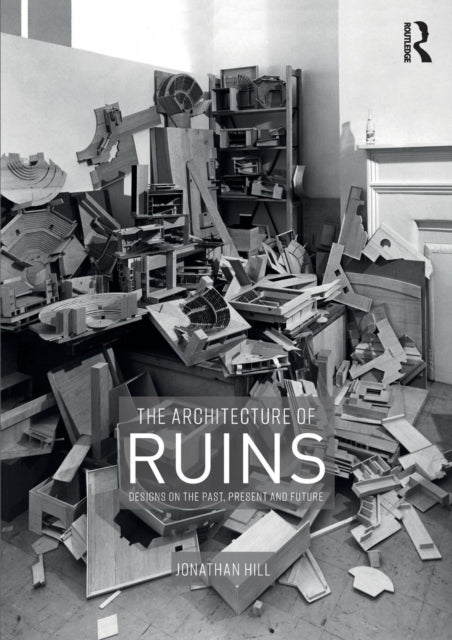JonathanHill
Architecture of Ruins: Designs on the Past, Present and Future
Architecture of Ruins: Designs on the Past, Present and Future
YOU SAVE £2.02
- Condition: Brand new
- UK Delivery times: Usually arrives within 2 - 3 working days
- UK Shipping: Fee starts at £2.39. Subject to product weight & dimension
Bulk ordering. Want 15 or more copies? Get a personalised quote and bigger discounts. Learn more about bulk orders.
Couldn't load pickup availability
- More about Architecture of Ruins: Designs on the Past, Present and Future
The Architecture of Ruins: Designs on the Past, Present, and Future explores an alternative history of architecture from the sixteenth century to the twenty-first century, where buildings are designed, occupied, and imagined as ruins. This practice addresses temporal and environmental questions, stimulates personal and national identity, nature and culture, and life and death. It conceives a building as a dialogue between a monument and a ruin, intensifying the relations between the unfinished and the ruined and envisioning the past, present, and future in a single architecture. The book emphasizes the interconnections between designers and the relevance of historical understanding to design, and explores an evolving, interdisciplinary practice to show the relevance of historical understanding to design. Ruins are full of potential and suggest the future as well as the past, expanding the allegorical and metaphorical capacity of architecture.
Format: Paperback / softback
Length: 358 pages
Publication date: 24 April 2019
Publisher: Taylor & Francis Ltd
The Architecture of Ruins: Designs on the Past, Present, and Future presents an alternative and profound history of architecture spanning from the sixteenth century to the twenty-first century. This design practice envisions a building as a ruin, where it is designed, occupied, and imagined. Within this framework, a monument and a ruin are treated as creative, interdependent, and simultaneous themes within a single architectural dialectic, addressing temporal and environmental concerns in poetic, psychological, and practical terms. This approach stimulates inquiries into personal and national identity, nature and culture, weather and climate, permanence and impermanence, and life and death. By conceiving a building as a dialogue between a monument and a ruin, the boundaries between the unfinished and the ruined are further blurred, and the past, present, and future are envisioned within a unified architectural framework.
Structured around a series of biographies, this book explores a monument and a ruin as metaphors for a life and tools for navigating between a self and a society. It emphasizes the interconnectedness between designers and the specific ways in which later architects have learned from their predecessors. The chapters delve into an evolving, interdisciplinary design practice to demonstrate the relevance of historical understanding to design.
Similar to a history, a design is a reinterpretation of the past that holds meaning for the present. It is also akin to fiction, compelling users to suspend disbelief. While histories and novels are typically expressed in words, they can also be depicted through drawings, cast in concrete, or planted in soil. The architect operates as both a "physical novelist" and a "physical historian," drawing upon various forms of expression to convey their ideas.
Like building sites, ruins are rich in potential. By revealing what is lost as well as what remains incomplete, a ruin suggests the possibility of future growth and transformation. Ruins serve as reminders of the transient nature of human existence and the impermanence of structures, encouraging us to appreciate the present moment and embrace the transformative power of design.
In conclusion, The Architecture of Ruins: Designs on the Past, Present, and Future offers a unique perspective on architecture that challenges traditional notions of monumentality and decay. By exploring the relationship between a monument and a ruin, this book encourages us to reimagine the past, present, and future through the lens of design. It prompts us to consider the interconnectedness of human beings, nature, and culture, and to explore the ethical and philosophical implications of our architectural choices. Through its rich narratives and interdisciplinary approach, this book serves as a valuable resource for architects, historians, and anyone interested in the transformative power of design.
Weight: 932g
Dimension: 245 x 185 x 21 (mm)
ISBN-13: 9781138367784
This item can be found in:
UK and International shipping information
UK and International shipping information
UK Delivery and returns information:
- Delivery within 2 - 3 days when ordering in the UK.
- Shipping fee for UK customers from £2.39. Fully tracked shipping service available.
- Returns policy: Return within 30 days of receipt for full refund.
International deliveries:
Shulph Ink now ships to Australia, Belgium, Canada, France, Germany, Ireland, Italy, India, Luxembourg Saudi Arabia, Singapore, Spain, Netherlands, New Zealand, United Arab Emirates, United States of America.
- Delivery times: within 5 - 10 days for international orders.
- Shipping fee: charges vary for overseas orders. Only tracked services are available for most international orders. Some countries have untracked shipping options.
- Customs charges: If ordering to addresses outside the United Kingdom, you may or may not incur additional customs and duties fees during local delivery.


